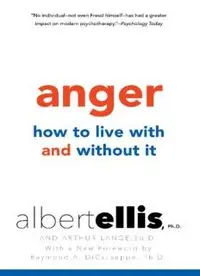
Anger: How to Live with and without It PDF
Preview Anger: How to Live with and without It
ALSO BY DR. ALBERT ELLIS How to Control Your Anger Before It Controls You How to Control Your Anxiety Before It Controls You How to Stop Destroying Your Relationships How to Keep People From Pushing Your Buttons How to Stubbornly Refuse to Make Yourself Miserable About Anything—Yes, Anything! The Albert Ellis Reader Available from the Citadel Press/Kensington Publishing Corp. Anger How to Live With and Without It Revised and Updated Albert Ellis, Ph.D. CITADEL PRESS Kensington Publishing Corp. www.kensingtonbooks.com All copyrighted material within is Attributor Protected. CITADEL PRESS BOOKS are published by Kensington Publishing Corp. 119 West 40th Street New York, NY 10018 Copyright © 1991, 2003 Albert Ellis Institute Foreword copyright © 2017 Albert Ellis Institute All rights reserved. No part of this book may be reproduced in any form or by any means without the prior written consent of the publisher, excepting brief quotes used in reviews. CITADEL PRESS and the Citadel logo are Reg. U.S. Pat. & TM Off. ISBN: 978-0-80653811-2 Updated electronic edition: March 2017 ISBN-13: 978-0-8065-3812-9 ISBN-10: 0-8065-3812-0 Library of Congress Control Number: 2002110882 For Janet L. Wolfe With love Table of Contents ALSO BY DR. ALBERT ELLIS Title Page Copyright Page Dedication Foreword Preface Acknowledgments Epigraph 1 - Must You Feel Angry? 2 - How You Create Your Own Anger: The ABCs of REBT 3 - The Insanity of Anger 4 - Looking for Self-Angering Philosophies 5 - Understanding Your Self-Angering Philosophies 6 - Disputing Your Self-Angering Philosophies 7 - Some Methods of Thinking Your Way out of Anger 8 - Some Methods of Feeling Your Way out of Anger 9 - Some Methods of Acting Your Way out of Anger 10 - More Rethinking About Your Anger 11 - Ripping Up Your Rationalizations for Remaining Angry 12 - More Ways of Overcoming Anger 13 - Accepting Yourself With Your Anger 14 - Postscript: How to Deal With International Terrorism Appendix: Techniques for Disputing Irrational Beliefs (DIBS) References About the Authors Foreword Whenever I give a talk on Rational Emotive Behavior Therapy (REBT) and discuss Dr. Albert Ellis’s theory of emotional disturbance—namely, that it is not things, people, or events that make us disturbed, but rather our beliefs about things, people, or events that create our emotional and behavioral disturbance—I tell the audience that there’s good and bad news to this idea. Let’s get the bad news out of the way . . . We have to face it: it feels really good to blame other people for our problems, to say, “My boss/spouse/child/customer service representative made me so angry!” That’s because it feels good not to take responsibility for our emotional reactions. However, if we subscribe to the theory espoused by Al (who credits it to the Greek philosopher Epictetus), we can’t blame others for our reactions. Ultimately, we are responsible for how we react emotionally and behaviorally. Well, that’s no fun. Now for the good news . . . I don’t know about you, but I haven’t been successful at controlling many of life’s events or the people in my life. That’s good news? Yes, because even though so much of life is out of our control, if we go along with Epictetus and Al, we can at least control how we respond. So what’s behind anger? If you have ever seen someone who was angry, you’ve definitely seen some type of demand or expectation being placed by that person on him-or herself, or on others, or on world conditions; the same was true for anyone who saw you when you were angry. Frustration intolerance in the form of “I-can’t-stand-it-itis” was also surely in evidence, as well as self-and other-downing. Next time you find yourself angry at something or someone, see which of these beliefs you’re holding. Anger: How to Live With and Without It was originally written in 1977, revised in 2003, and is now being relaunched in a new print edition and as an e- book. In the 2003 edition, Al wrote a postscript entitled “How to Deal With International Terrorism,” which was largely a response to the September 11, 2001, terror attacks. Now, Al trained and mentored me, and I worked with him for many years; I knew he was a genius. After reading this postscript, however, I couldn’t escape an eerie feeling about him. He had deconstructed the mind-set of the terrorists, using the concepts of REBT, and he had also provided readers remarkable tools to cope with those tragic events. Unfortunately, obnoxious and unfair behavior on the one hand and international terrorism on the other have only increased throughout the years, and neither seems to be going away anytime soon. Al’s outstanding insight, experience, and foresight, evidenced in Anger: How to Live With and Without It, make this self-help book in its entirety, and the postscript in particular, still applicable and relevant to the world we live in today. Perhaps more important, the tools he provides to address the reader’s unhealthy anger are a gift that will keep on giving no matter how the world is in the future. Albert Ellis dedicated his life to helping people with their emotional and behavioral upsets. What would he say about how germane his comments and suggestions remain in today’s unstable, unpredictable world? I envision him with that big smile, in his confident (but not cocky) tone, saying, “It’s simply because REBT works!” —Raymond A. DiGiuseppe, Ph.D.
